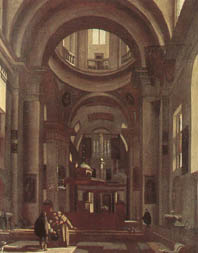 Emanuel de Witte was born in Alkmaar in 1617 and studied painting with Evert van Aelst.
Emanuel de Witte was born in Alkmaar in 1617 and studied painting with Evert van Aelst.
He started his career as portrait painter but was not successful and turning to painting church interiors, a genre in which he excelled. Listed as a master in Alkmaar in 1636 he went to work in Rotterdam in 1639 and became a member of the Guild of Delft in 1641 before settling in Amsterdam in 1652.
Only a few artists, and perhaps only Saenredam, managed to render the luminous aspect of church interiors like he did. His figures were painted with minute and exquisite touch.
De Witte instilled more colours in his paintings than other painters of cathedrals who generally chose grey tones to produce their works. He surely was a great master of perspective and of light effects.
His masterpiece was Woman Playing the Harpsichord, now in the museum of Rotterdam, a remarkable piece exhaling his virtuoso touch regarding perspective through a series of rooms decorated with carpets and furniture and lit by a dim sunlight coming through invisible windows. In the background a window defines the space which opens on a cold light while the face of the young musician is reflecting in a mirror in front of her. This extraordinary scene evokes Vermeer and his painting The Painters Studio produced some 15 years after that work. De Witte committed suicide at 75 in 1692.